Evaluation of Microlenses, Color Filters, and Polarizing Filters in CIS for Space Applications
Abstract
1. Introduction
2. Experimental Details
2.1. Devices
2.2. Optical Stacks
2.2.1. Microlenses
2.2.2. Color Filter Array (CFA)
2.2.3. Polarizing Filters
2.3. Measurements
2.3.1. Studied Parameters
2.3.2. Environmental Tests
- -
- Thermal cycling: this test consists of submitting samples alternatively to extreme high and low temperatures for a certain amount of time. This corresponds to strong thermal gradients for several cycles. This allows us to determine the evolution of optical properties of materials and the occurrence of delamination, cracks, outgassing, and interface weakening.
- -
- Humidity or moisture test: samples are exposed to a given amount of humidity, reflecting worst-case conditions that devices could handle during ground storage. This reveals distortion, corrosion, material clocking, or swelling in case of humidity absorption.
- -
- High-Temperature Storage (HTS): samples are exposed to a high temperature for a long time (usually several thousands of hours) in order to ensure long-term reliability and outgassing troubles. This corresponds to accelerated aging.
- -
- Vacuum test: devices exposed to vacuum can suffer from layers ungluing or outgassing.
- -
- Radiations: samples are exposed to several types of particles representative of space conditions. Indeed, devices cannot be protected by the atmosphere, and they are directly exposed to particles and high energetic photons from radiation belts and solar eruptions, leading to cumulative effects such as Total Ionizing Dose (TID) or Total Non-Ionizing Dose (TNID). In order to ensure tolerance to space radiations, devices are usually exposed to gamma (Cobalt 60) for ionizing effects and protons for both ionizing and non-ionizing effects. Sometimes, X-rays may also be used to evaluate robustness with regard to ionizing doses. TID can induce ionization of the material, and TNID can modify the crystalline structure, both leading to the modification of optical properties, such as darkening [18].
- -
- UV test: this test evaluates the tolerance to UV from the sun due to the lack of Ozone layer. Polymers can thus be ionized, leading to darkening of materials [19].
- -
- Cleaning: devices may be cleaned during system integration because of molecular or particle contamination. For this purpose, acetone and IPA ethanol are evaluated in order to determine if they can be used without any effects on the sensors.
- -
- Thermal cycling: Interfaces between optical stack and silicon can be weakened because of ungluing, leading to a worse charge collection.
- -
- Humidity: humidity absorption can lead to the modification of layers or distortion of filters/microlenses. This would decrease the charge collection efficiency. Moreover, pollution and outgassing can induce unwanted particles in front of optical stack, which would also prevent charges from being collected.
- -
- High-temperature storage: The evolution of optical properties can be followed, such as darkening of materials, for example. Darkening would lead to charge collection lowering.
- -
- Vacuum: Layer ungluing or outgassing can also impact the charge collection efficiency.
- -
- Radiations and UV: Ionizing and non-ionizing effects can lead to break of polymer chain [20], inducing the darkening of material. Consequently, the material would become less transparent for incident light, which would reduce the charge collection efficiency.
3. Impact of Space Environment on CIS Technologies
3.1. Foundry A: Humidity, Thermal Cycling, HTS, UV, Vacuum, and Radiation
3.1.1. Humidity and Thermal Cycling
3.1.2. High-Temperature Storage
3.1.3. UV Insolation
3.1.4. Vacuum
3.1.5. Radiations
3.2. Foundry B: Humidity, Thermal Cycling, HTS, UV, and Radiation
3.2.1. Humidity and Thermal Cycling
3.2.2. High-Temperature Storage
3.2.3. UV Insolation
3.2.4. Radiations
3.3. Foundry C: Radiations, HTS, Thermal Cycling, and Humidity
3.4. Foundry D: Thermal Cycling, Humidity, and HTS
3.5. Foundry E: Radiations
3.6. Foundry F: Radiation
4. Discussion
- -
- Thermal cycling/humidity: no visual defects have been observed, and there was no significant degradation in quantum efficiency (results remain within the measurement uncertainties). This means that optical stacks have not been impacted, no ungluing nor weakening occurred due to thermal cycling, and no mechanical distortion nor modification of layers occurred due to humidity.
- -
- HTS: No noticeable variation in QE was observed, which means that optical modification occurred. Optical stacks are suitable for long-term applications.
- -
- Vacuum: No variation in behavior was observed due to vacuum exposition. Thus, no ungluing nor outgassing occurred.
- -
- Radiations: Small variations were observed for devices C.2 and E, but the total cumulative dose of radiation tests were higher than the usual space mission’s needs (more than 1 Mrad). For other devices, no clear radiation damage was observed up to the maximum total dose.
- -
- UV: Some ionizing effects were observed, leading to a decrease of 15% in quantum efficiency. This may be due to the darkening of the material. However, this decrease (~15%) is lower than the gain due to the addition of an optical stack (+50% at minimum from Figure 7). In other words, the QE of designs with microlenses after the environmental test is still higher than the QE of designs without microlenses before the environmental test. Optical instrument designers have to be careful with the UV range when designing the system.
5. Conclusions
Author Contributions
Funding
Institutional Review Board Statement
Informed Consent Statement
Data Availability Statement
Acknowledgments
Conflicts of Interest
References
- Cai, S.; Sun, Y.; Chu, H.; Yang, W.; Yu, H.; Liu, L. Microlenses arrays: Fabrication, materials, and applications. Microsc. Res. Tech. 2021, 84, 2784–2806. [Google Scholar] [CrossRef] [PubMed]
- Guerrero, D.J.; DiMenna, W.; Flaim, T.D.; Mercado, R.; Sun, S. Dyed red, green, and blue photoresist for manufacture of high-resolution color filter arrays for image sensors. In Sensors and Camera Systems for Scientific, Industrial, and Digital Photography Applications IV; SPIE: Bellingham, WA, USA, 2003; pp. 298–306. [Google Scholar] [CrossRef]
- Sarkar, M.; Bello, D.S.S.S.S.; van Hoof, C.; Theuwissen, A. Integrated Polarization Analyzing CMOS Image Sensor for Material Classification. IEEE Sens. J. 2011, 11, 1692–1703. [Google Scholar] [CrossRef]
- Maurice, S.; Wiens, R.C.; Bernardi, P.; Caïs, P.; Robinson, S.; Nelson, T.; Gasnault, O.; Reess, J.-M.; Deleuze, M.; Rull, F.; et al. The SuperCam Instrument Suite on the Mars 2020 Rover: Science Objectives and Mast-Unit Description. Space Sci. Rev. 2021, 217, 47. [Google Scholar] [CrossRef]
- Maki, J.N.; Gruel, D.; McKinney, C.; Ravine, M.A.; Morales, M.; Lee, D.; Willson, R.; Copley-Woods, D.; Valvo, M.; Goodsall, T.; et al. The Mars 2020 Engineering Cameras and Microphone on the Perseverance Rover: A Next-Generation Imaging System for Mars Exploration. Space Sci. Rev. 2020, 216, 1–48. [Google Scholar] [CrossRef] [PubMed]
- Virmontois, C.; Belloir, J.-M.; Beaumel, M.; Vriet, A.; Perrot, N.; Sellier, C.; Bezine, J.; Gambart, D.; Blain, D.; Garcia-Sanchez, E.; et al. Dose and Single-Event Effects on a Color CMOS Camera for Space Exploration. IEEE Trans. Nucl. Sci. 2019, 66, 104–110. [Google Scholar] [CrossRef]
- Ulamec, S.; Michel, P.; Grott, M.; Böttger, U.; Hübers, H.W.; Murdoch, N.; Pierre, V.; Kaaekn, Ö.; Jörg, K.; Konrad, W.; et al. A Rover for the Jaxa Mmx Mission to Phobos. In Proceedings of the 70th International Astronautical Congress, IAC, Washington, DC, USA, 21–25 October 2019. IAC-19-A3.4.B8. [Google Scholar]
- Yokoyama, T.; Tsutsui, M.; Suzuki, M.; Nishi, Y.; Mizuno, I.; Lahav, A. Development of Low Parasitic Light Sensitivity and Low Dark Current 2.8 μm Global Shutter Pixel. Sensors 2018, 18, 349. [Google Scholar] [CrossRef] [PubMed]
- Zanella, F.; Basset, G.; Schneider, C.; Luu-Dinh, A.; Fricke, S.; Madrigal, A.M.; Van Aken, D.; Zahir, M. Microlens testing on back-illuminated image sensors for space applications. Appl. Opt. 2020, 59, 3636–3644. [Google Scholar] [CrossRef] [PubMed]
- Teranishi, N.; Watanabe, H.; Ueda, T.; Sengoku, N. Evolution of optical structure in image sensors. In Proceedings of the 2012 International Electron Devices Meeting, San Francisco, CA, USA, 10–13 December 2012; pp. 533–536. [Google Scholar]
- Bayer, B.E. Color Imaging Array. US3971065A, 5 March 1975. [Google Scholar]
- Zapryanov, G.; Nikolova, I. Comparative Study of Demosaicing Algorithms for Bayer and Pseudo-Random Bayer Color Filter Arrays. Available online: https://www.researchgate.net/profile/Georgi-Zapryanov/publication/256696331_Comparative_Study_of_Demosaicing_Algorithms_for_Bayer_and_Pseudo-Random_Bayer_Color_Filter_Array/links/00b49523a0052a4f0c000000/Comparative-Study-of-Demosaicing-Algorithms-for-Bayer-and-Pseudo-Random-Bayer-Color-Filter-Array.pdf (accessed on 2 March 2023).
- 3.0Mm-pixels and 1.5 pm-pixels combined CMOS Image Sensor for Viewing and Sensing Applications with 106dB Dynamic Range, High-Sensitivity, LED-Flicker Mitigation and Motion Blur-less. In Proceedings of the 2023 International Image Sensor Workshop (IISW), Scotland, UK, 21–25 May 2023.
- Geelen, B.; Blanch, C.; Gonzalez, P.; Tack, N.; Lambrechts, A. A tiny VIS-NIR snapshot multispectral camera. In Advanced Fabrication Technologies for Micro/Nano Optics and Photonics VIII; SPIE: San Francisco, CA, USA, 2015; pp. 194–201. [Google Scholar] [CrossRef]
- Tisserand, S. Custom Bayer Filter Multispectral Imaging: Emerging Integrated Technology. In Proceedings of the 2019 10th Workshop on Hyperspectral Imaging and Signal Processing: Evolution in Remote Sensing (WHISPERS), Amsterdam, The Netherland, 24–26 September 2019; pp. 1–4. [Google Scholar] [CrossRef]
- Accurate Estimation of Conversion Gain and Quantum Efficiency in CMOS Imagers. Available online: https://www.spiedigitallibrary.org/conference-proceedings-of-spie/5017/0000/Accurate-estimation-of-conversion-gain-and-quantum-efficiency-in-CMOS/10.1117/12.483900.full (accessed on 4 May 2023).
- El Gamal, A.; Eltoukhy, H. CMOS image sensors. IEEE Circuits Devices Mag. 2005, 21, 6–20. [Google Scholar] [CrossRef]
- Doyle, D. Radiation Hardness of Optical Materials, 3rd Europa Jupiter System Mission Instrument Workshop, ESA ESTEC January 2010. Available online: https://sci.esa.int/documents/34530/36042/1567257330700-EJSM3IW_09_Radiation-Hardness-of-Optical-Materials_Doyle.pdf (accessed on 2 March 2023).
- Study of the Surface Modification of the PMMA by UV-Radiation|Elsevier Enhanced Reader. Available online: https://reader.elsevier.com/reader/sd/pii/S1877705809000575?token=768301A37FFFC91692CDCF190B958D6359C6EAEB1FB7C90AF13BB356F417037D0362715793E2BA9FEDDC8046E0774EB9&originRegion=eu-west-1&originCreation=20230210082244 (accessed on 10 February 2023).
- Alexander, P.; Charlesby, A.; Ross, M. The degradation of solid polymethylmethacrylate by ionizing radiation. Proc. R. Soc. London. Ser. A Math. Phys. Sci. 1997, 223, 392–404. [Google Scholar] [CrossRef]
- Goiffon, V.; Rizzolo, S.; Corbiere, F.; Rolando, S.; Bounasser, S.; Sergent, M.; Chabane, A.; Marcelot, O.; Estribeau, M.; Magnan, P.; et al. Total Ionizing Dose Effects on a Radiation-Hardened CMOS Image Sensor Demonstrator for ITER Remote Handling. IEEE Trans. Nucl. Sci. 2018, 65, 101–110. [Google Scholar] [CrossRef]
- Goiffon, V.; Rolando, S.; Corbiere, F.; Rizzolo, S.; Chabane, A.; Girard, S.; Baer, J.; Estribeau, M.; Magnan, P.; Paillet, P.; et al. Radiation Hardening of Digital Color CMOS Camera-on-a-Chip Building Blocks for Multi-MGy Total Ionizing Dose Environments. IEEE Trans. Nucl. Sci. 2017, 64, 45–53. [Google Scholar] [CrossRef]
- Goiffon, V.; Estribeau, M.; Magnan, P. Overview of Ionizing Radiation Effects in Image Sensors Fabricated in a Deep-Submicrometer CMOS Imaging Technology. IEEE Trans. Electron. Devices 2009, 56, 2594–2601. [Google Scholar] [CrossRef]
- Lane, C.; Rode, D.; Roesgen, T. Calibration of a polarization image sensor and investigation of influencing factors. Appl. Opt. 2022, 61, C37–C45. [Google Scholar] [CrossRef] [PubMed]
- Rebhan, D.; Rosenberger, M.; Notni, G. Principle investigations on polarization image sensors. In Photonics and Education in Measurement Science; SPIE: Bellingham, WA, USA, 2019; pp. 50–54. [Google Scholar] [CrossRef]
- Goiffon, V.; Allanche, T.; Muller, C.; Girard, S.; Paillet, P.; Macé, J.R.; Osmond, M.; Burnichon, P.; Plumeri, S.; Baudu, J.-P.; et al. CAMRAD: Development of a Multi-Megagray Radiation Hard CMOS Camera for Dismantling Operations. In Proceedings of the Dismantling Challenges: Industrial Reality, Prospects and Feedback Experience (DEM 2018), Avignon, France, 22–24 October 2018. [Google Scholar]
- Watanabe, T.; Takeuchi, T.; Ozawa, O.; Komanome, H.; Akahori, T.; Tsuchiya, K. A Radiation-Hardened CMOS Image Sensor with Pixels Exhibiting a Negligibly Small Dark-Level Increase During Ionizing Radiation. IEEE Trans. Nucl. Sci. 2020, 67, 1835–1845. [Google Scholar] [CrossRef]
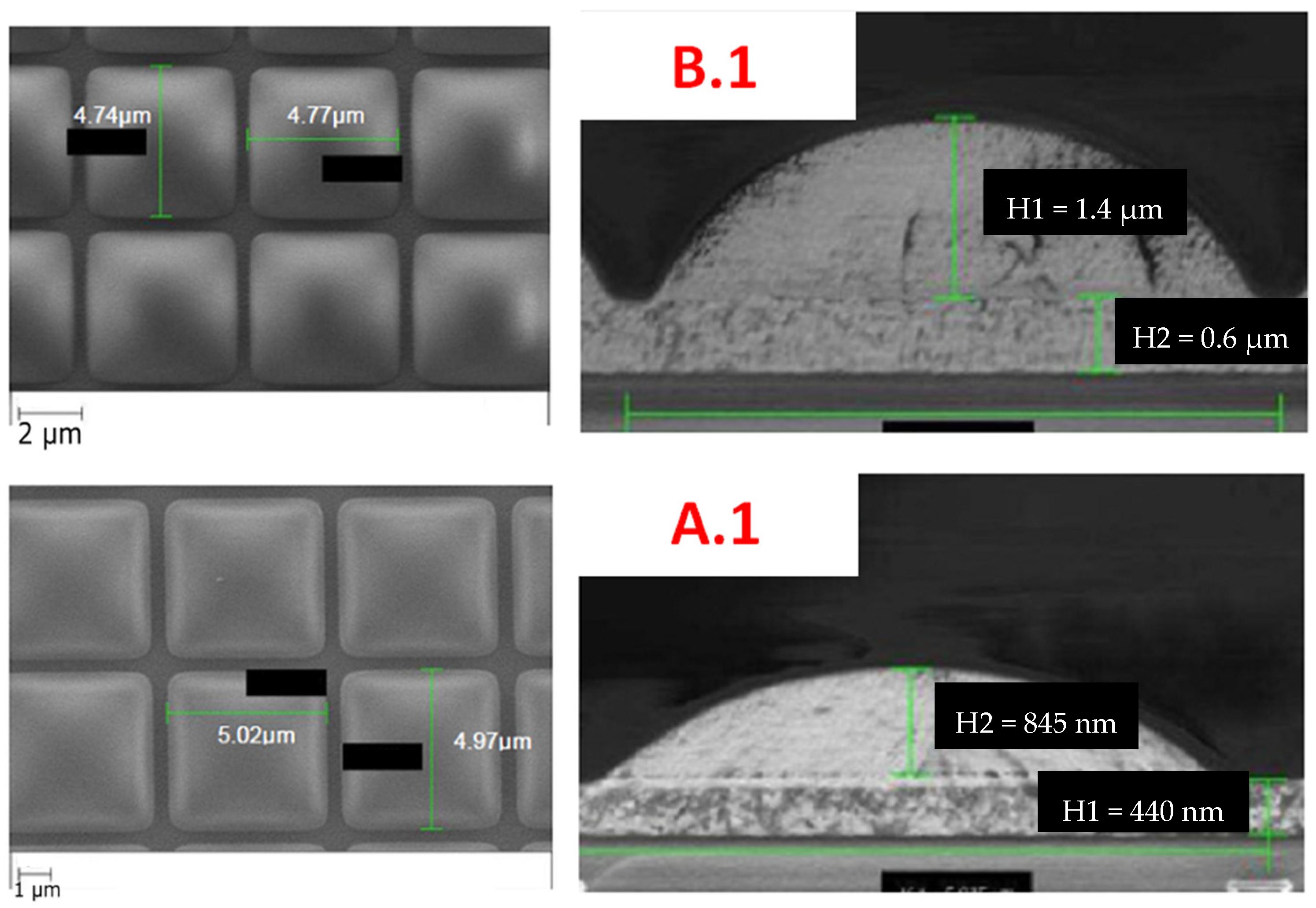



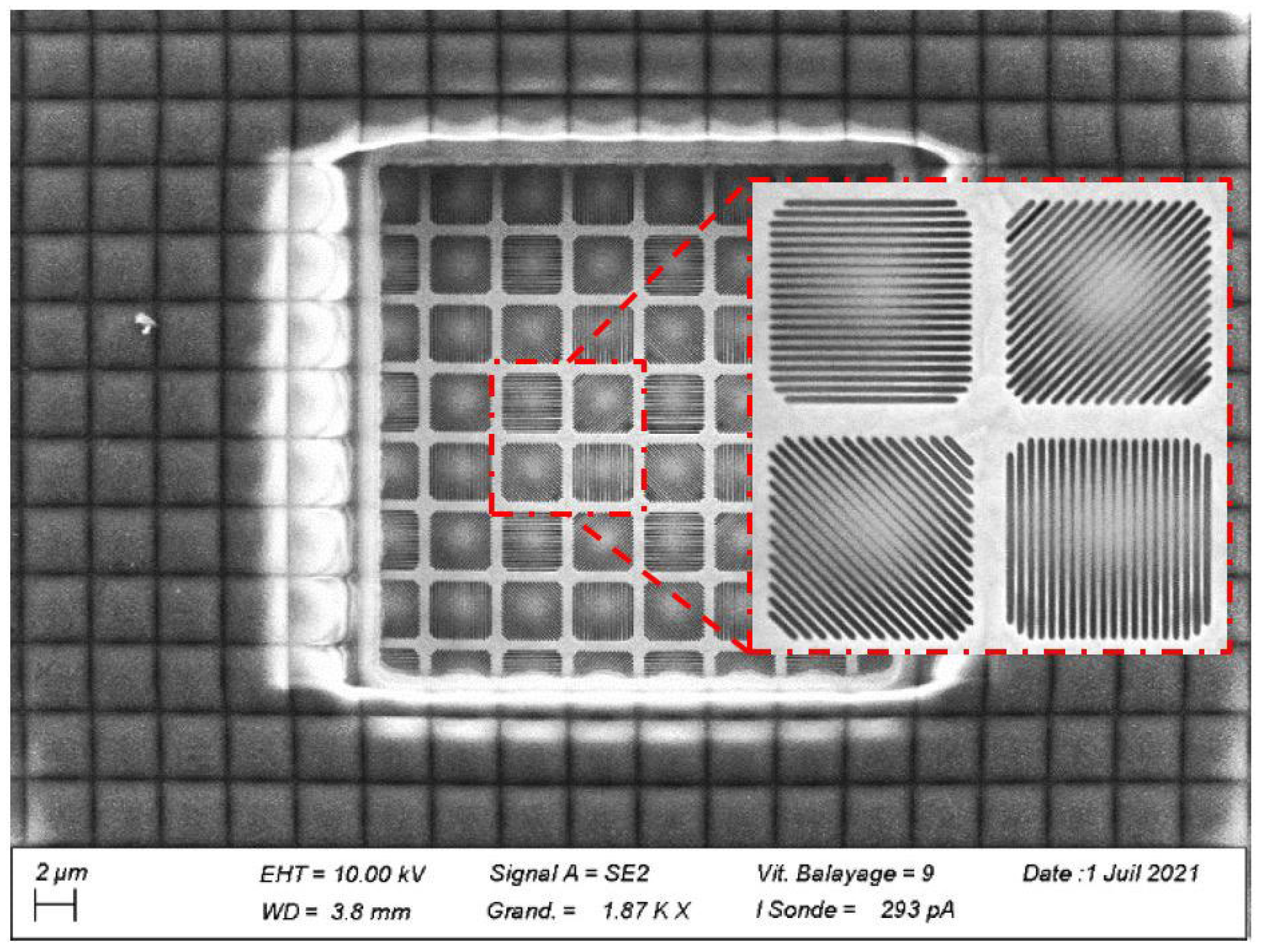

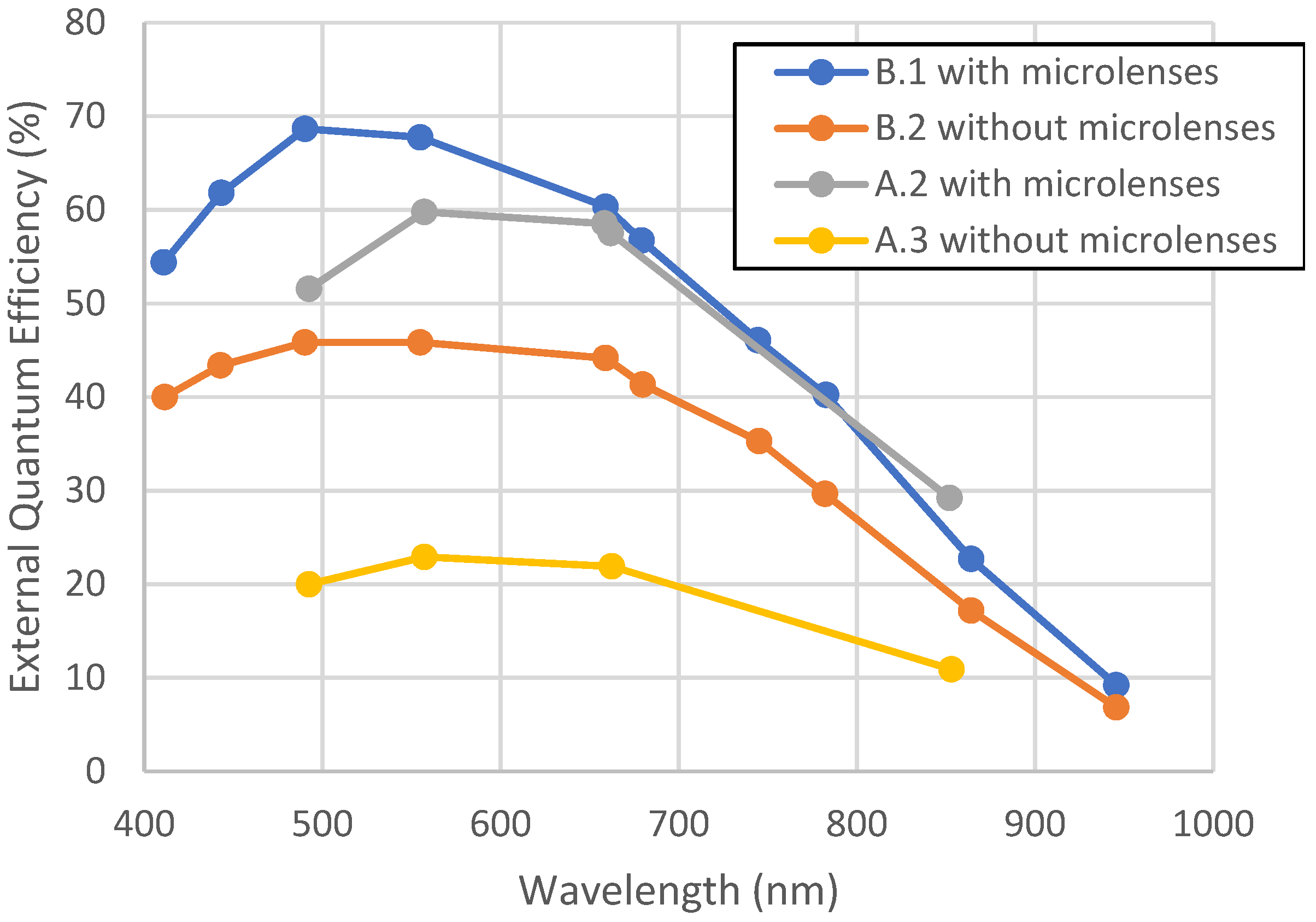
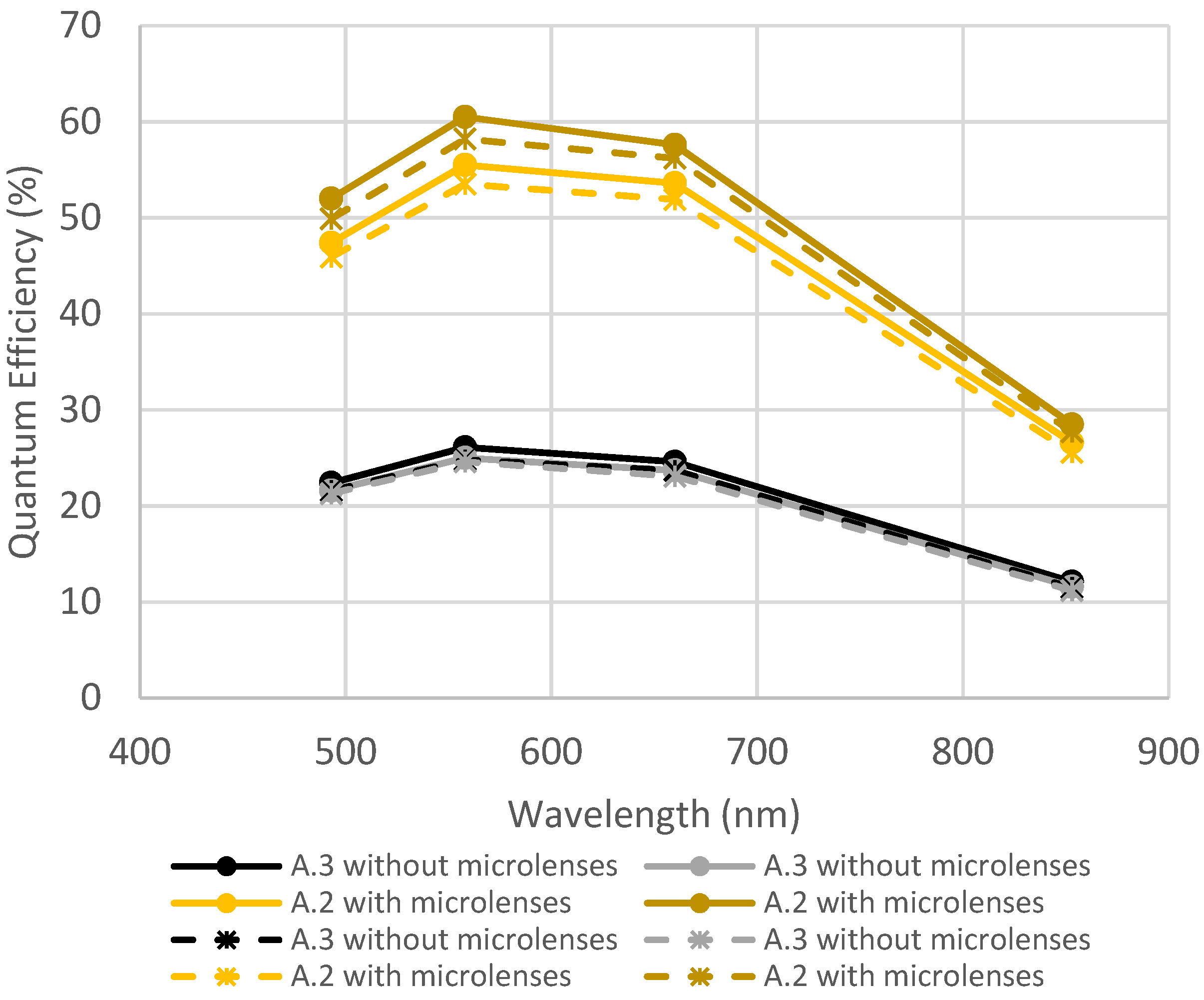


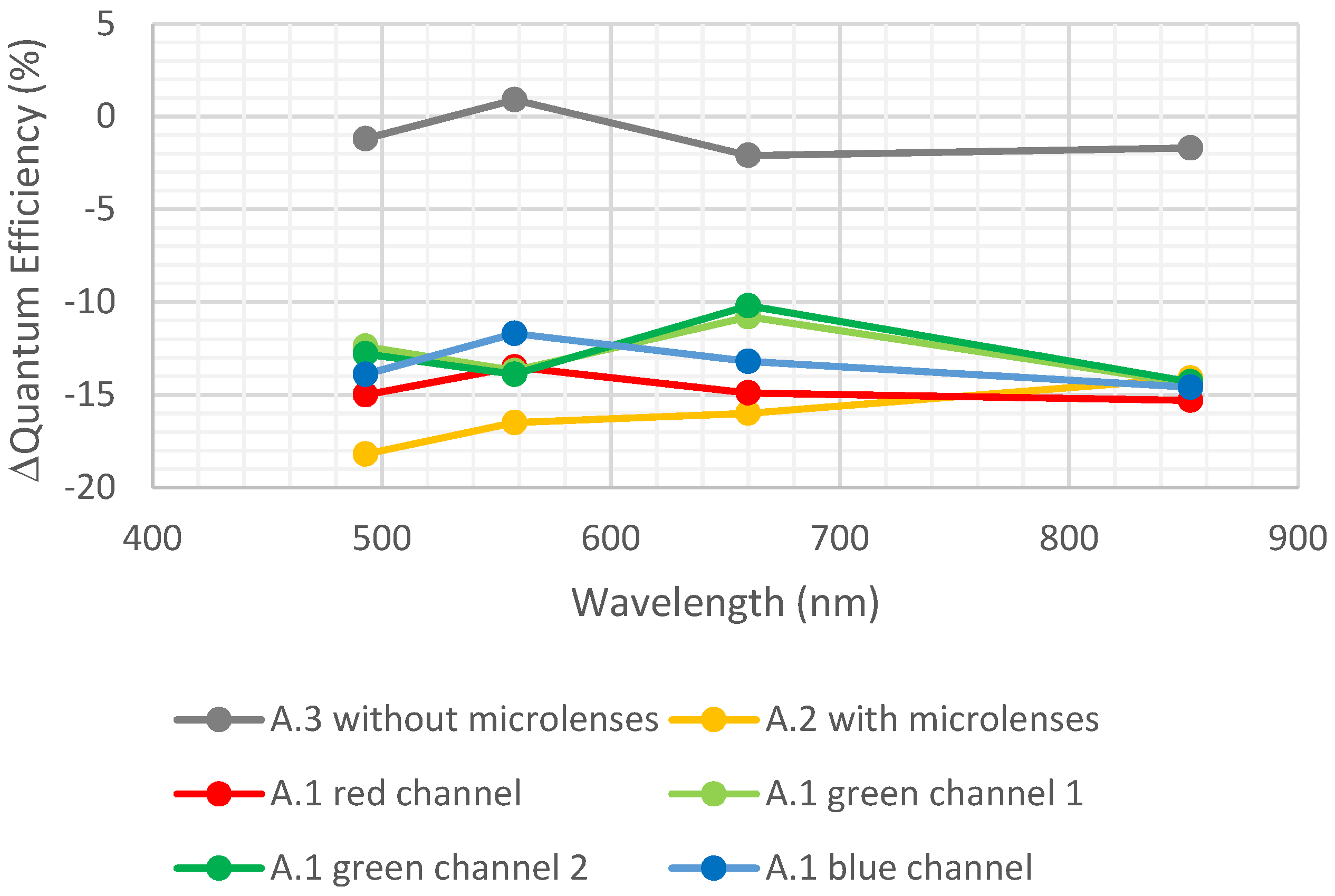
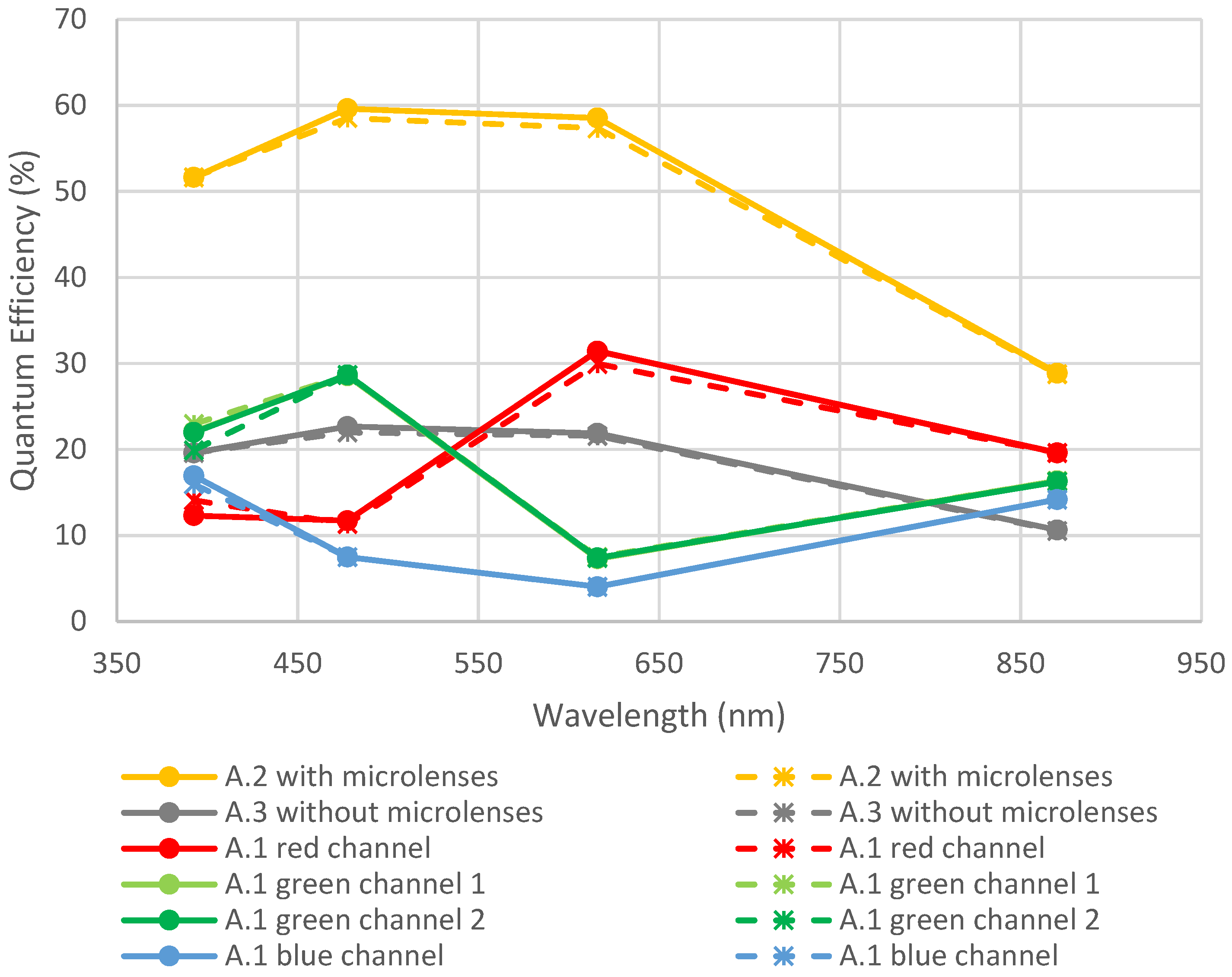
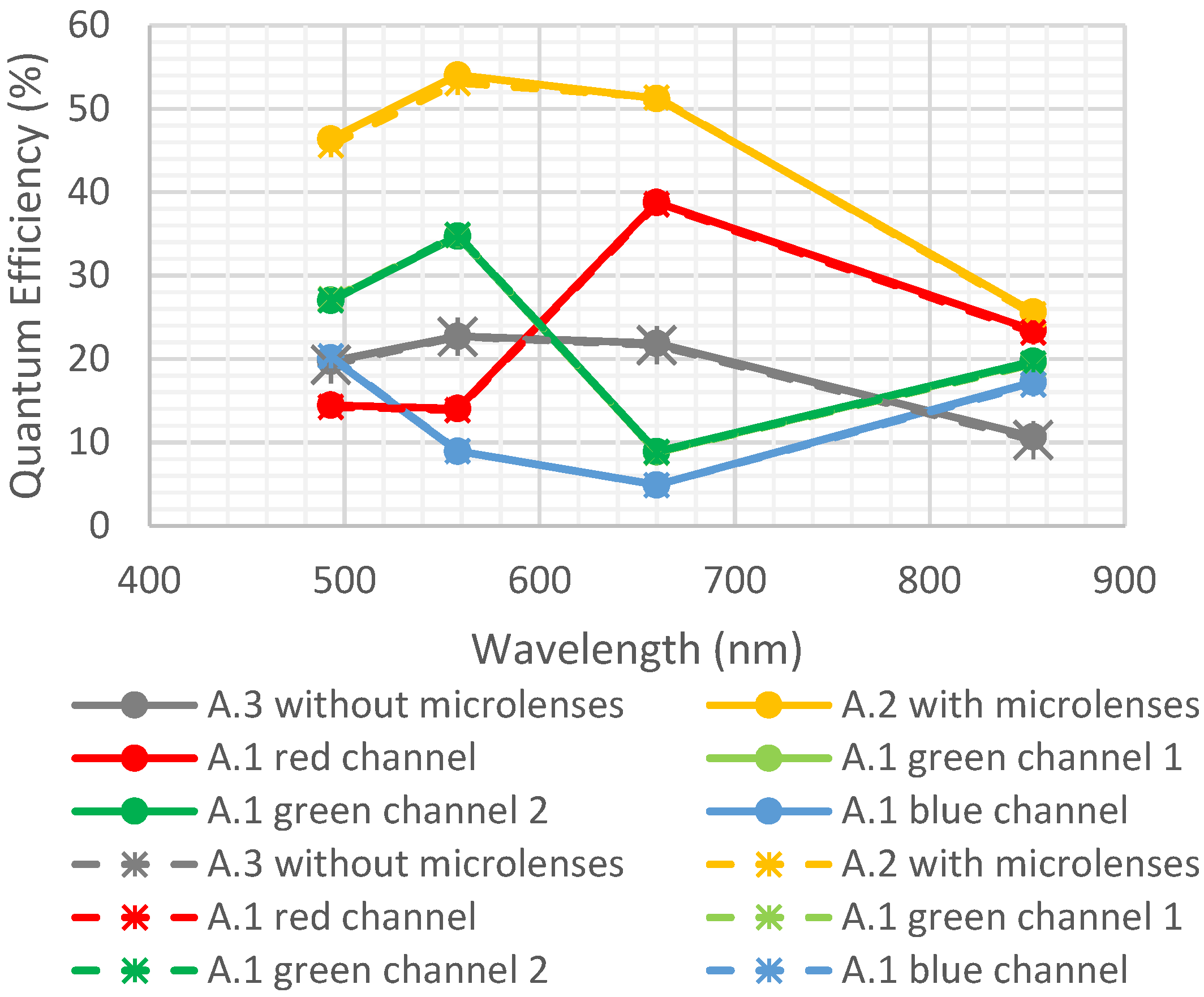
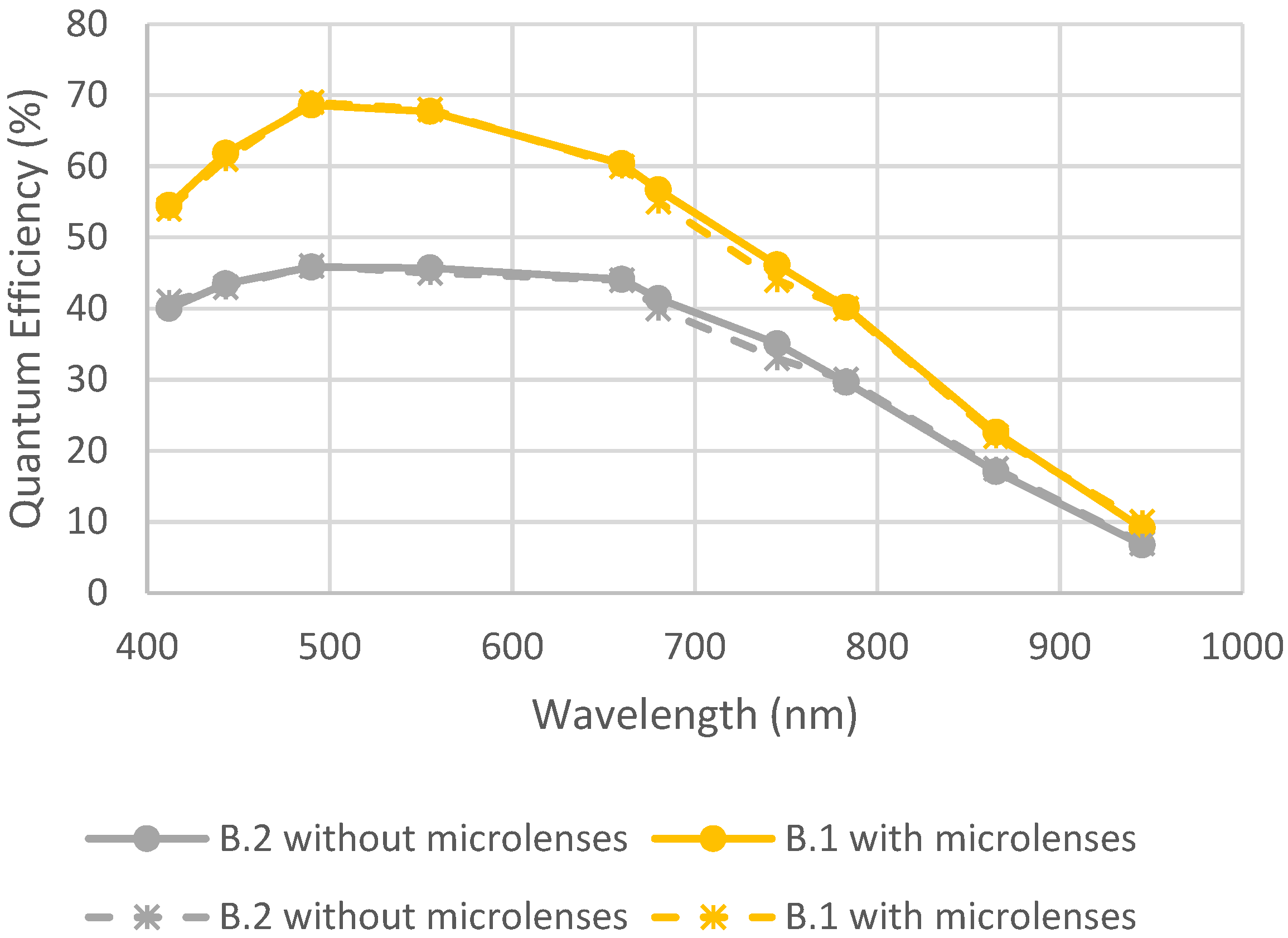
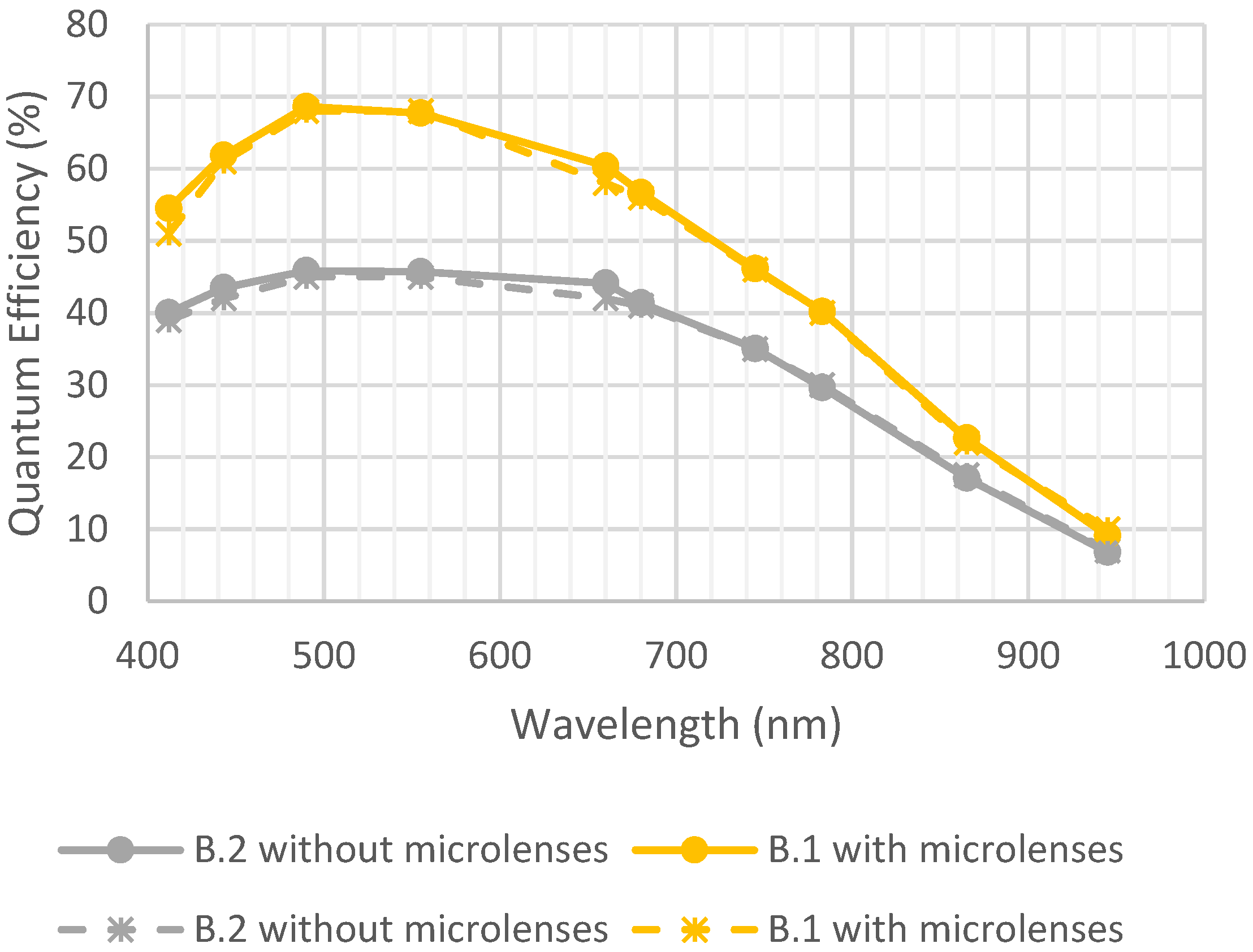
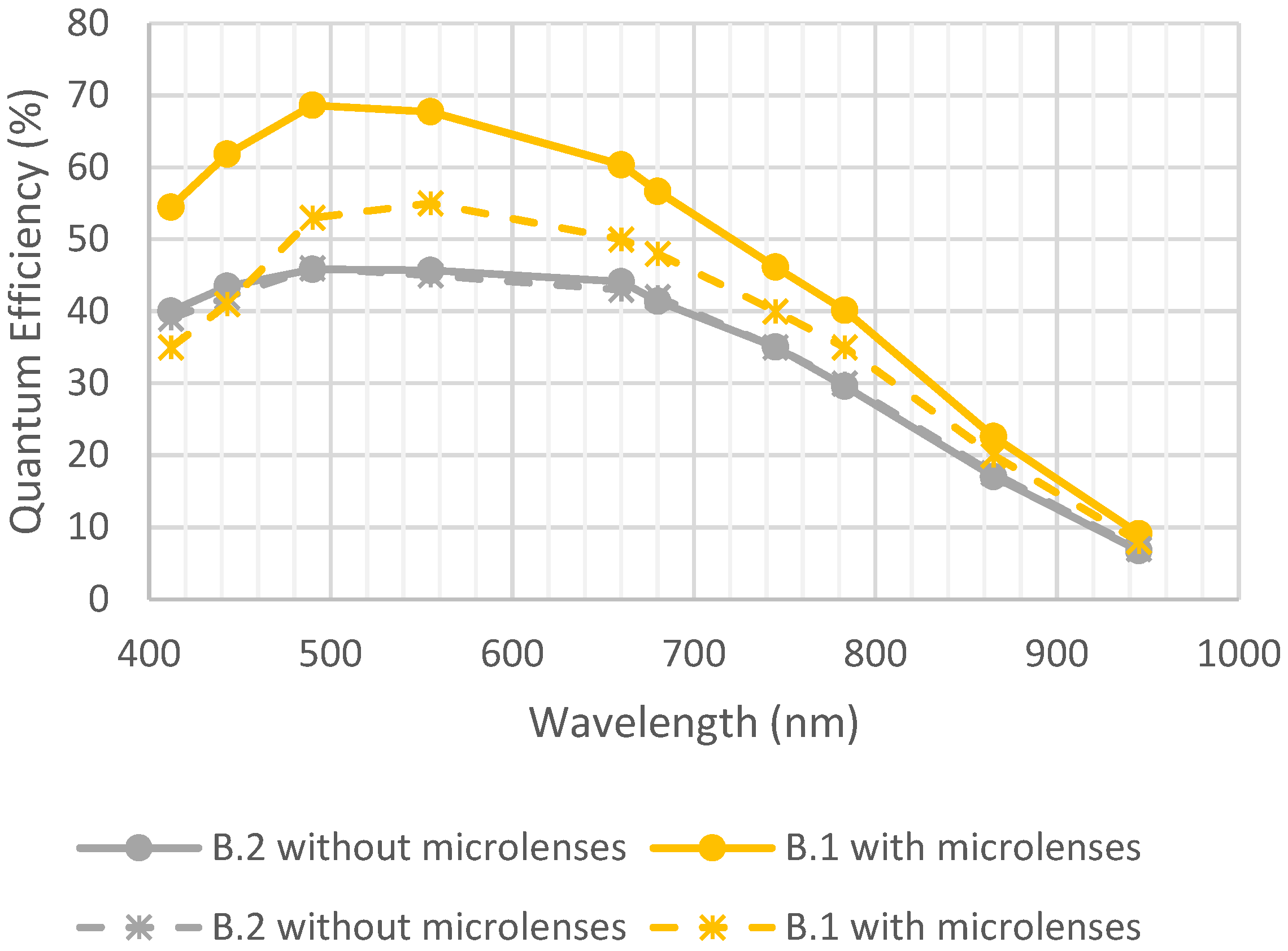
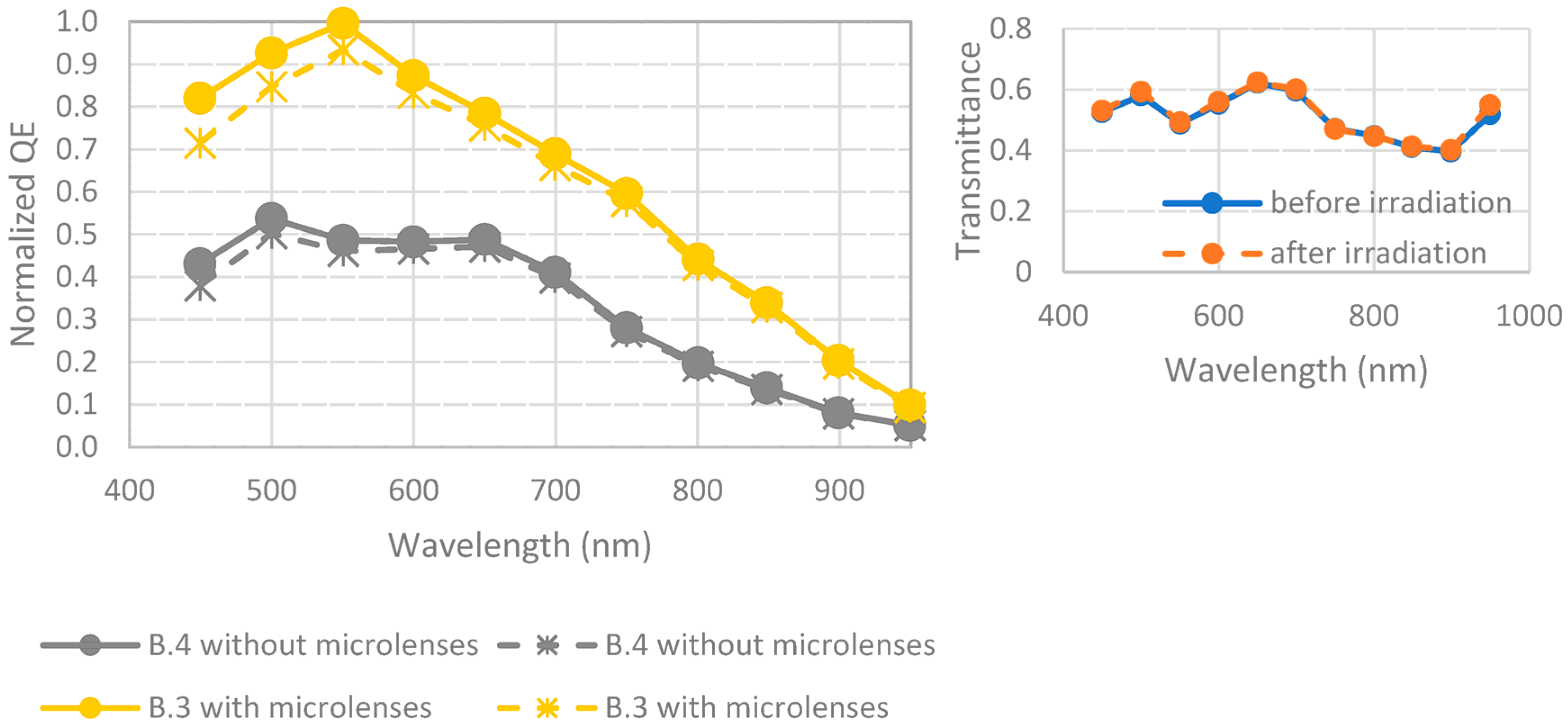


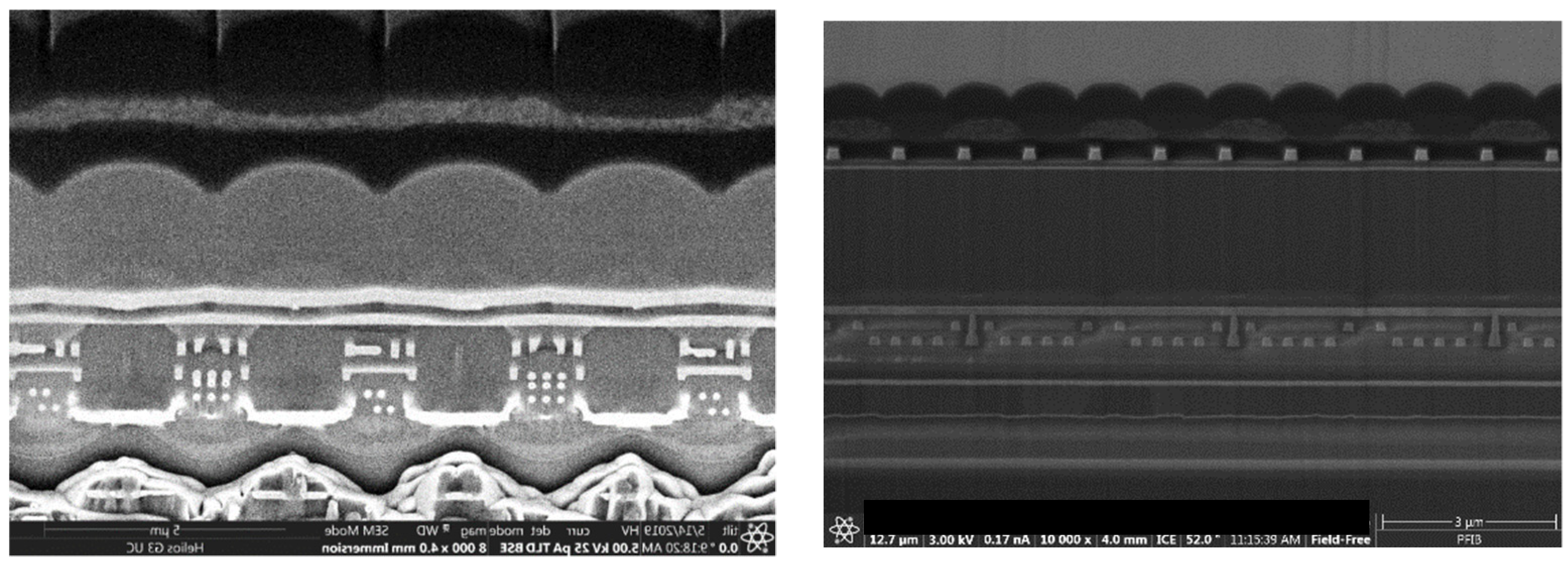
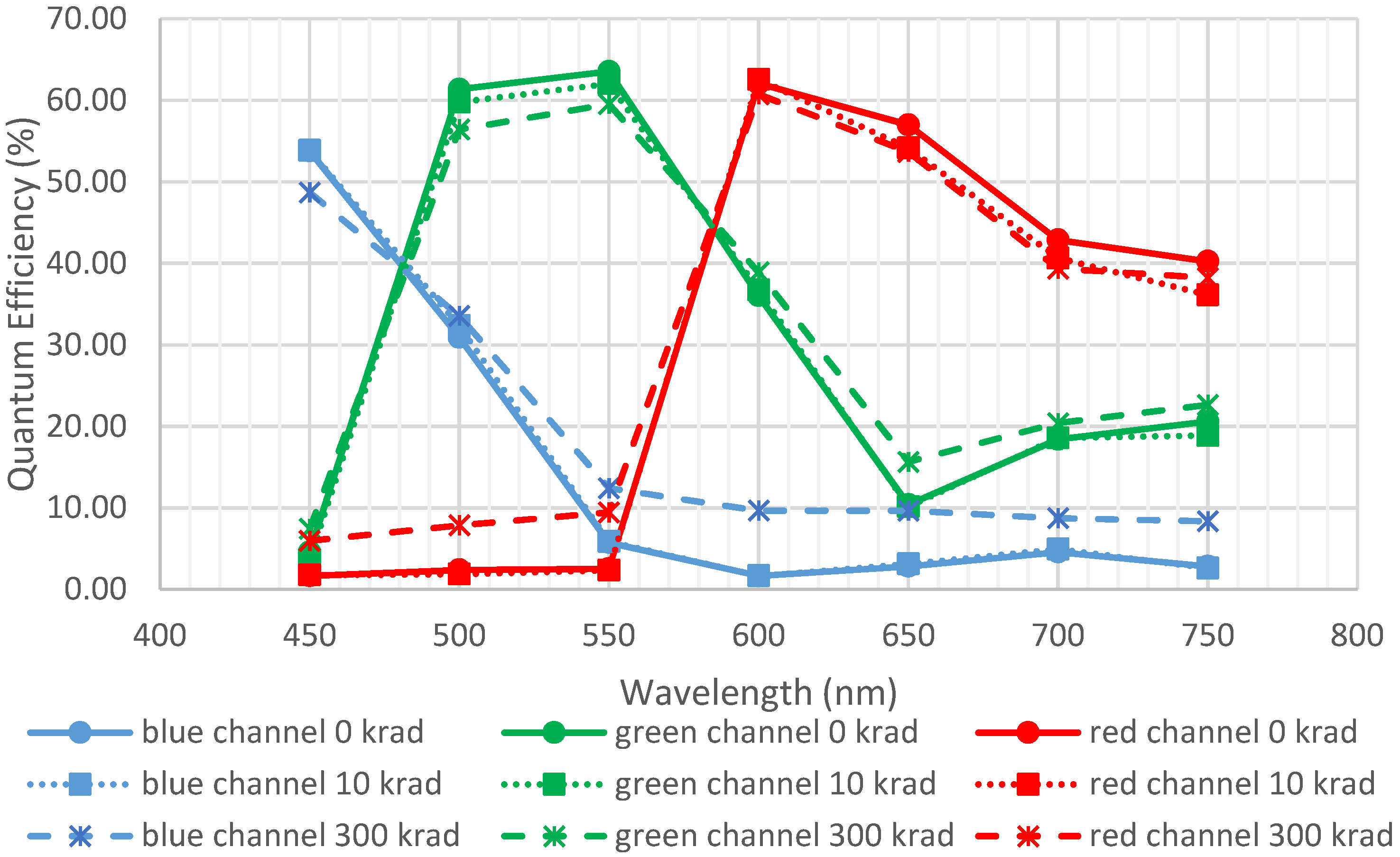
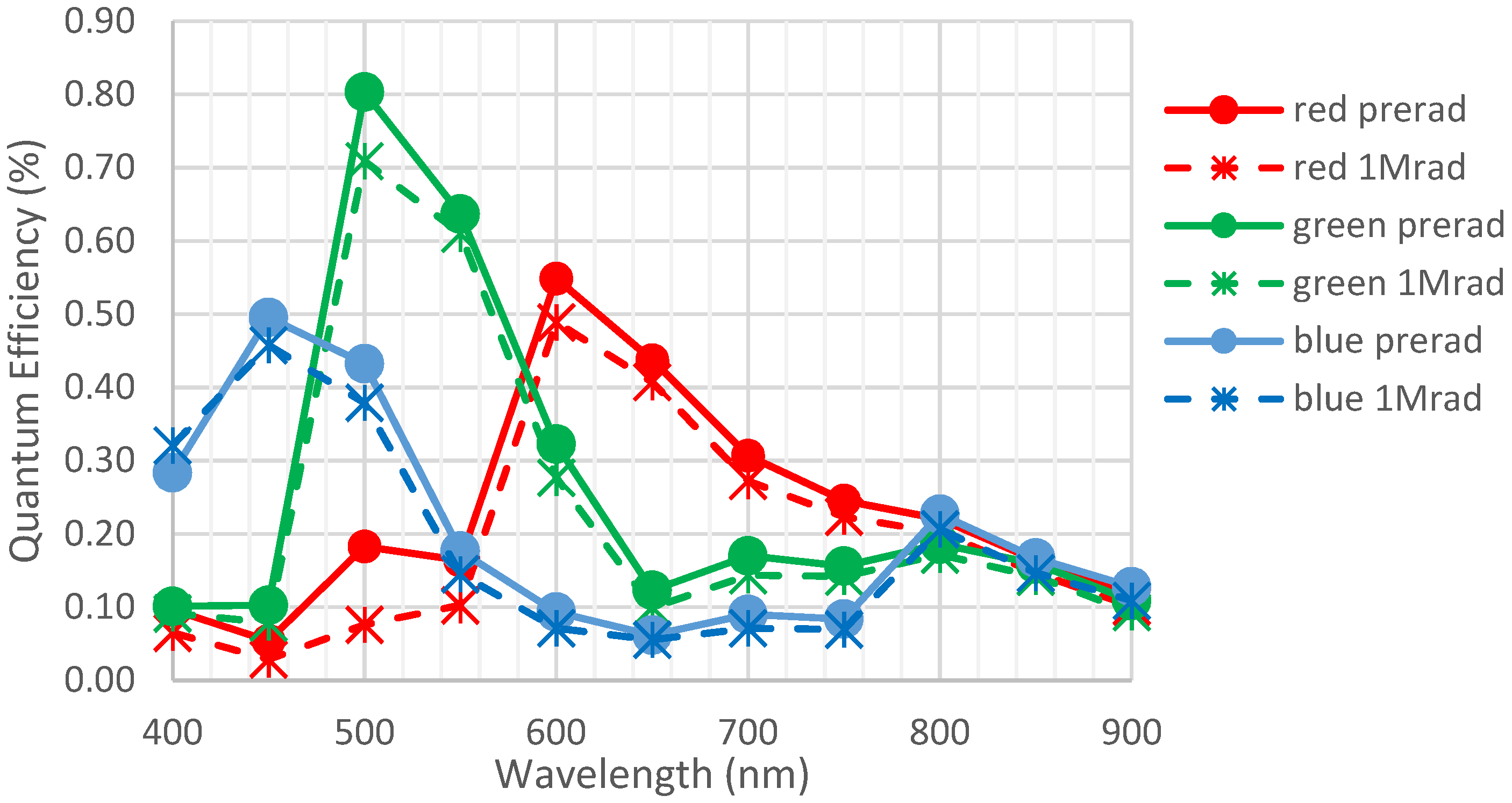
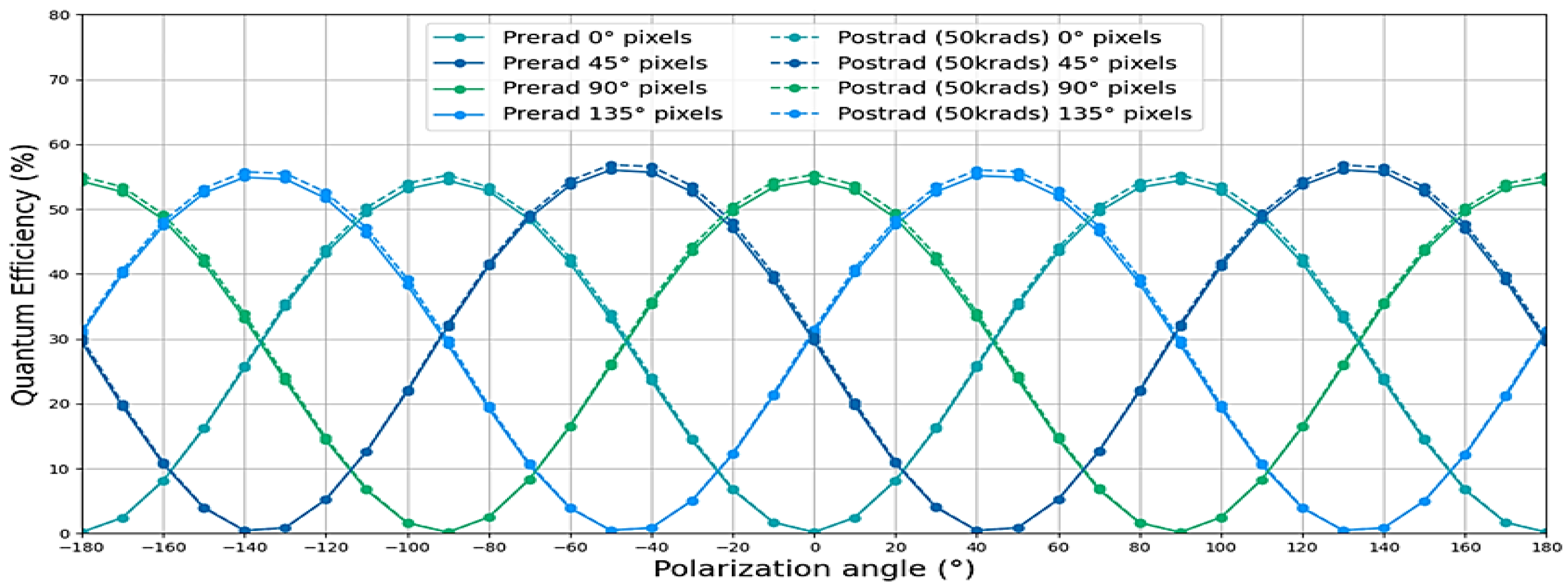

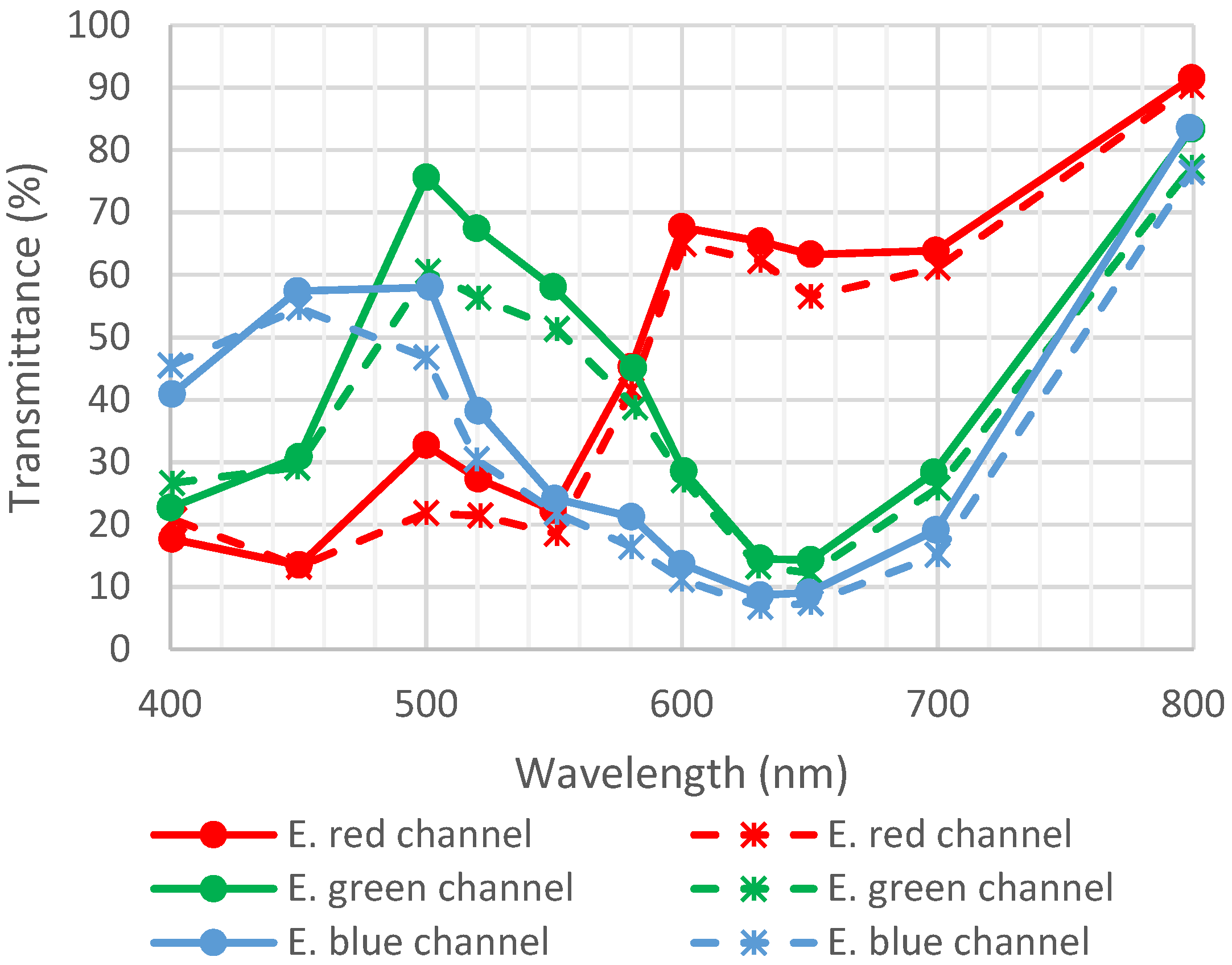
| Foundry.Device | Technology Node (nm) | Pixel Pitch (µm) | Illumination | Microlenses | Color Filter Array | Polarizing Filters |
|---|---|---|---|---|---|---|
| A.1 | 180 | 5.5 | FSI | Y | Y | N |
| A.2 | 180 | 5.5 | FSI | Y | N | N |
| A.3 | 180 | 5.5 | FSI | N | N | N |
| B.1 | 180 | 5 | FSI | Y | N | N |
| B.2 | 180 | 5 | FSI | N | N | N |
| B.3 | 180 | 7 | FSI | Y | N | N |
| B.4 | 180 | 10 | FSI | N | N | N |
| B.5 | 180 | 10 | FSI | N | Y | N |
| B.6 | 180 | 10 | FSI | N | Y | N |
| C.1 | 65 | 3.45 | FSI | Y | Y | N |
| C.2 | 65 | 1.1 | BSI | Y | Y | N |
| C.3 | 65 | 3.45 | FSI | Y | N | Y |
| D | 110 | 2.8 | FSI | Y | Y | N |
| E | 180 | 8.5 | FSI | Y | Y | N |
| F | 90 FEOL | 13/26/52 | FSI | Y | N | N |
| 65 BEOL | 13/26/52 |
| UV | Thermal Cycling/Humidity (RH: Room Humidity) | High-Temperature Storage (HTS) | Vacuum | Radiations | |
|---|---|---|---|---|---|
| Foundry A | 96 h at 0.6 solar unity | 500 h at 70 °C and 70% RH + 50 cycles (−55 °C/125 °C) under nitrogen and atmospheric pressure | 1000 h at 100 °C | 1 week at <10−6 Torr | 50 MeV protons up to 2 × 1011 p/cm2 |
| Foundry B | 96 h at 0.6 solar unity (B.1 and B.2) | 500 h at 70 °C and 70% RH + 50 cycles (−55 °C/125 °C) under nitrogen and atmospheric pressure (B.1 and B.2) | 1000 h at 100 °C (B.1 and B.2) | Co60 100 krad (B.3 and B.4) Co60 600 Mrad (B.5) 10 keV Xrays 1 Grad (B.5) | |
| Foundry C | 500 cycles −55 °C/125 °C + 500 h at 70% RH and 70 °C (C.1) | 2000 h at 125 °C (C.1) | 49.7 MeV protons up to 2 × 1012 p/cm2 (C.1) Co60 1 Mrad (C.2) Co60 50 krad (C.3) | ||
| Foundry D | 500 cycles −55 °C/125 °C + 500 h at 70% RH and 70 °C | 2000 h at 125 °C | |||
| Foundry E | Co60 100 Mrad | ||||
| Foundry F | 49.7 MeV protons up to 1 × 1011 p/cm2 Co60 10 krad |
| UV | Thermal Cycling/Humidity | HTS | Vacuum | Radiation | |
|---|---|---|---|---|---|
| Foundry A | ~15% | <5% | <5% | <5% | <5% |
| Foundry B | ~15% | <5% | <5% | <5% | |
| Foundry C | No major change (C.1) | No major change (C.1) | ~5% (C.1) ~10% (C.2) <5% (C.3) | ||
| Foundry D | No major change | No major change | |||
| Foundry E | <10% | ||||
| Foundry F | <5% |
Disclaimer/Publisher’s Note: The statements, opinions and data contained in all publications are solely those of the individual author(s) and contributor(s) and not of MDPI and/or the editor(s). MDPI and/or the editor(s) disclaim responsibility for any injury to people or property resulting from any ideas, methods, instructions or products referred to in the content. |
© 2023 by the authors. Licensee MDPI, Basel, Switzerland. This article is an open access article distributed under the terms and conditions of the Creative Commons Attribution (CC BY) license (https://creativecommons.org/licenses/by/4.0/).
Share and Cite
Durnez, C.; Virmontois, C.; Panuel, P.; Antonsanti, A.; Goiffon, V.; Estribeau, M.; Saint-Pé, O.; Lalucaa, V.; Berdin, E.; Larnaudie, F.; et al. Evaluation of Microlenses, Color Filters, and Polarizing Filters in CIS for Space Applications. Sensors 2023, 23, 5884. https://doi.org/10.3390/s23135884
Durnez C, Virmontois C, Panuel P, Antonsanti A, Goiffon V, Estribeau M, Saint-Pé O, Lalucaa V, Berdin E, Larnaudie F, et al. Evaluation of Microlenses, Color Filters, and Polarizing Filters in CIS for Space Applications. Sensors. 2023; 23(13):5884. https://doi.org/10.3390/s23135884
Chicago/Turabian StyleDurnez, Clémentine, Cédric Virmontois, Pierre Panuel, Aubin Antonsanti, Vincent Goiffon, Magali Estribeau, Olivier Saint-Pé, Valérian Lalucaa, Erick Berdin, Franck Larnaudie, and et al. 2023. "Evaluation of Microlenses, Color Filters, and Polarizing Filters in CIS for Space Applications" Sensors 23, no. 13: 5884. https://doi.org/10.3390/s23135884
APA StyleDurnez, C., Virmontois, C., Panuel, P., Antonsanti, A., Goiffon, V., Estribeau, M., Saint-Pé, O., Lalucaa, V., Berdin, E., Larnaudie, F., Belloir, J.-M., Codreanu, C., & Chavanne, L. (2023). Evaluation of Microlenses, Color Filters, and Polarizing Filters in CIS for Space Applications. Sensors, 23(13), 5884. https://doi.org/10.3390/s23135884






